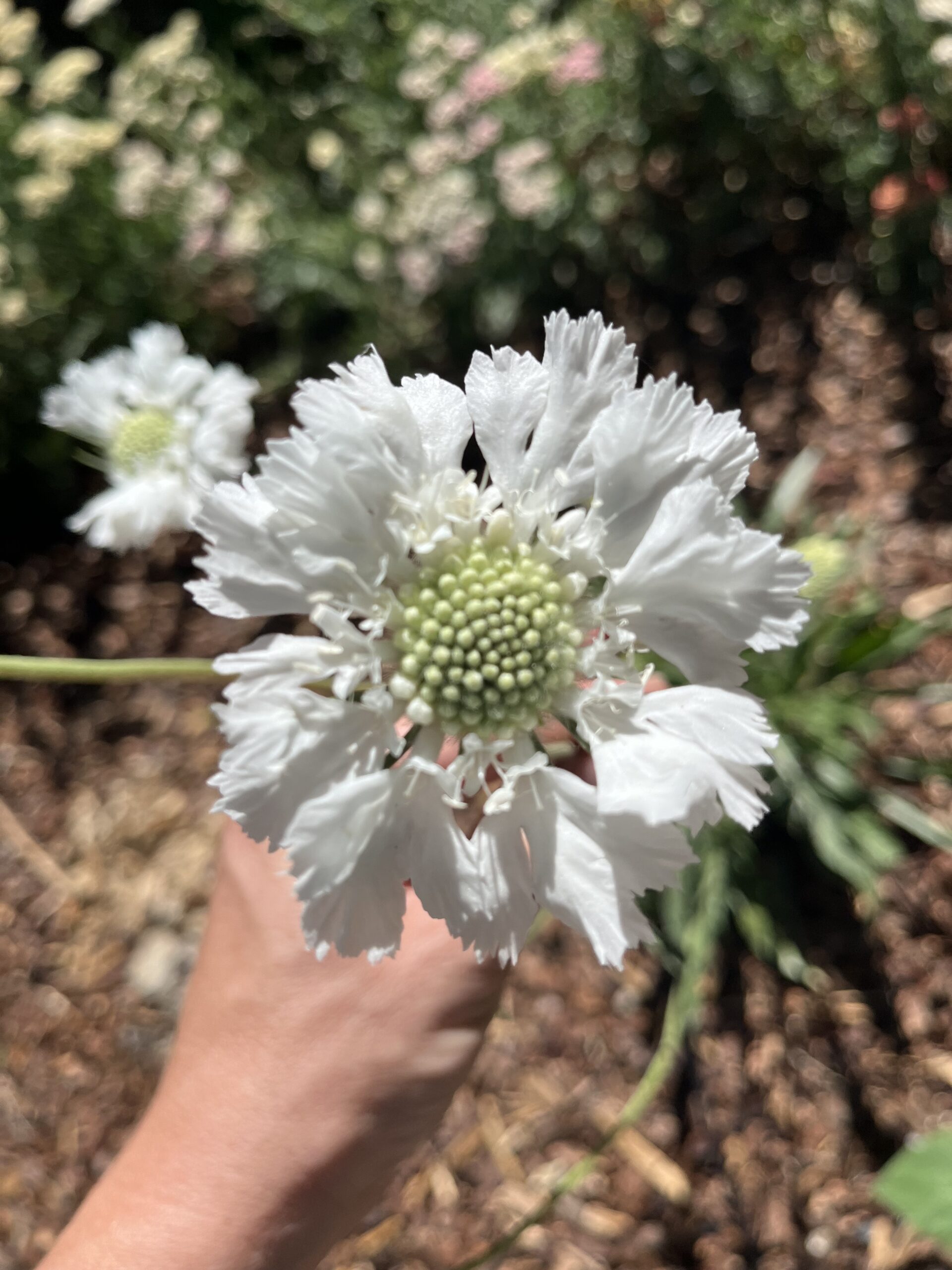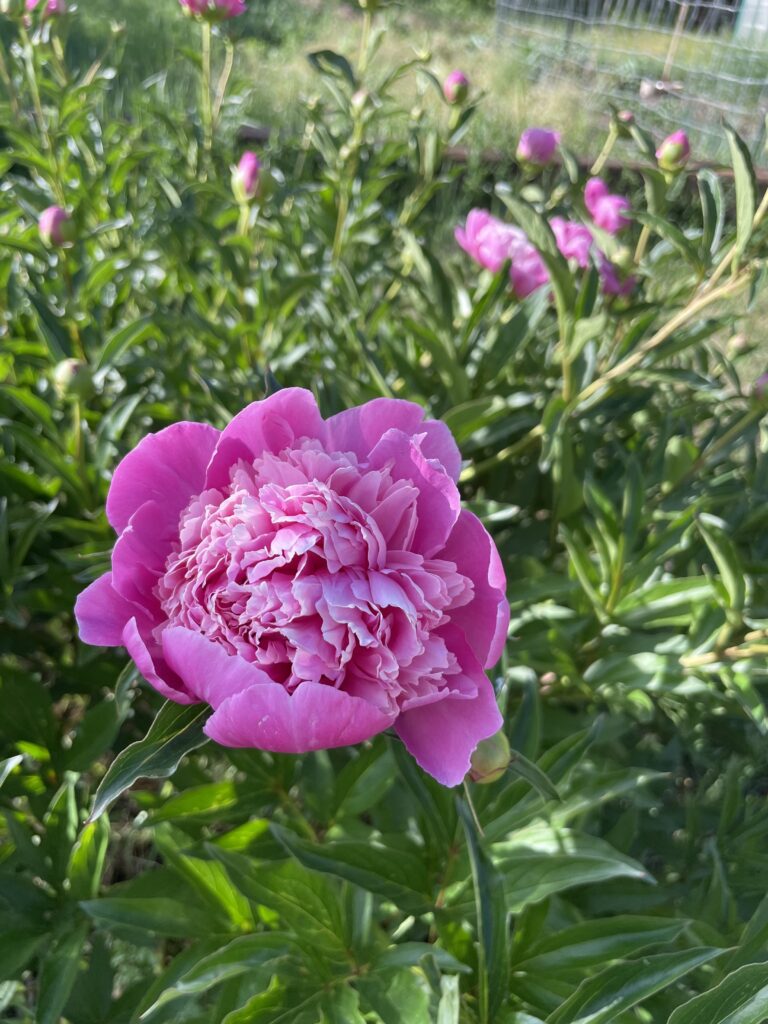Easy Guide to Growing Zinnias, The Best Flower!
How to Grow Zinnias
Growing zinnias are great for beginners and are great cut flowers. They are cut and come again flowers, meaning that the more you cut them, the more flowers you will get. They are also disease resistant and love the hot summer heat. There are also SO many varieties of zinnias, so the combinations are endless. Zinnias also have a long vase life, nice long stems, and can be pressed or dried. Follow the steps below for beautiful blooms all summer long.
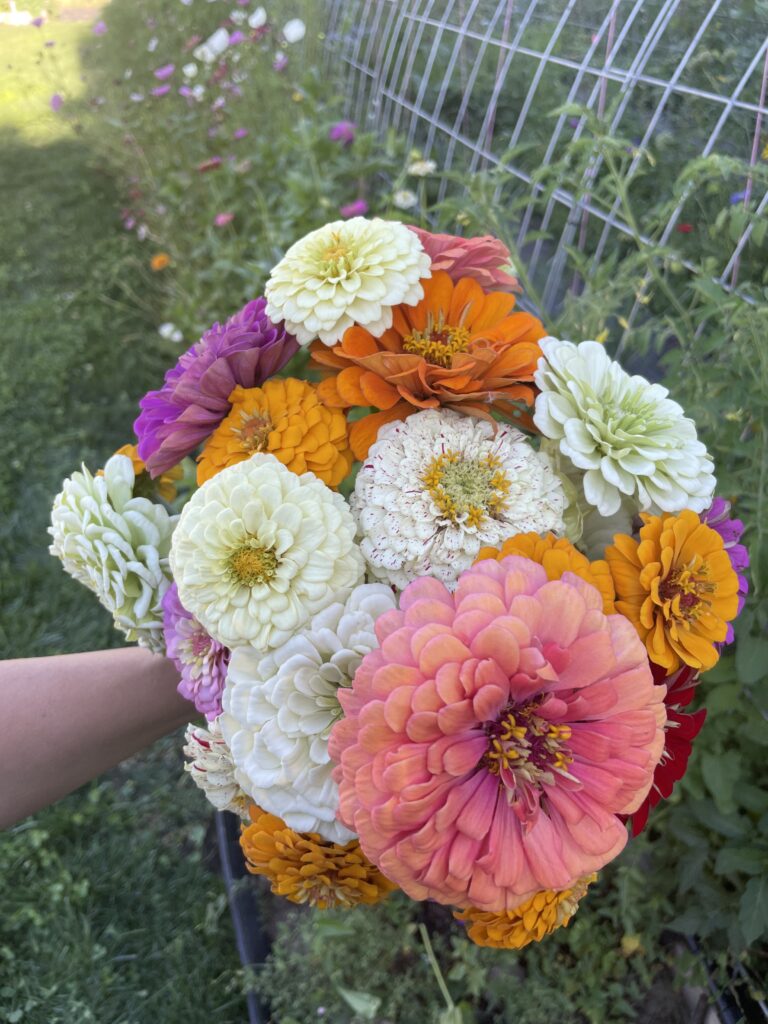
Choose the Right Location
When growing zinnias it is important to choose the right location. Zinnias need full sun to thrive, so select a spot that gets at least 6-8 hours of direct sunlight a day. They prefer warm, well-draining soil.
Prepare the Soil
Prepare your soil by clearing any grass or weeds.
Zinnias are not too fussy about soil quality, but they grow best in well-draining, moderately fertile soil. You can enrich your soil by mixing in some compost or organic matter if your soil is heavy or clay-like. If your soil is sandy or very loose, adding some compost will help retain moisture and provide nutrients.
Growing Zinnias From Seeds
- When to Plant: Plant zinnia seeds after the last frost in spring when your night temperatures are no lower than 40 degrees. Usually anytime April-July, but check your weather and last frost date to be sure. You can also start seeds indoors if you want to get a head start, but this is not necessary.
- Direct Sowing: You can plant seeds directly into your prepared location. Make a ¼ inch hole and put 2-3 seeds in each hole. I like to use the back of a sharpie for the perfect hole. Spacing seeds about 6-8 inches apart.
Indoor Start: If you want to get a head start plant the seeds in any small container 4-6 weeks before the last frost. Use seed trays or pots, and place them under grow lights. A sunny window will not be bright enough and will result in a “leggy” seedling that will be weak and can fall over. If you start seedlings indoors you will also need to “harden off” the seedlings before planting. Harding off is getting the plants used to the outside elements. If you take the seedling directly indoors to outdoors it can be killed by the sun, or broken from the wind.
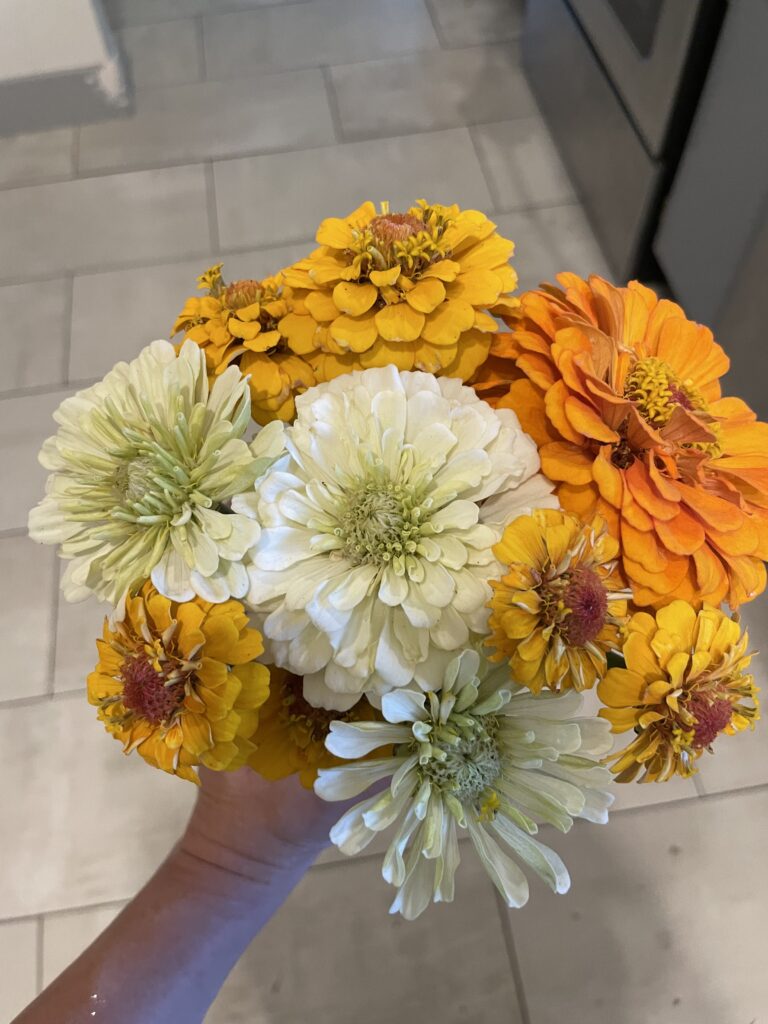
Watering
Zinnias need regular watering, especially when they are young and establishing roots. However, they do not like to sit in waterlogged soil. Water the base of the plant to avoid wetting the foliage, which can lead to fungal diseases. Deep watering once a week is typically enough, but in hot weather, they may need more frequent watering such as every other day or twice a week.
Thinning and Spacing
Once the seedlings have 3-4 sets of leaves, thin them out to 1 plant every 6 inches so they have enough room to grow. Zinnia plants need adequate air circulation, but since we are growing these flowers to cut our plants can be closer than some seed packets suggest 6-8 inches apart will work great. If you live in a more humid climate you might want to plant 10 inches apart to increase airflow and prevent disease.
Pinching Your Growing Zinnias
When your plant has reached 6-8 inches tall and has 4-5 sets of leaves. Pinch or cut the top stem and leaves off the plant. This will make the plant have two main stems instead of one. This will result in a bushier plant and more flowers with longer stems.
Fertilizing
It is important to know that growing zinnias do not need a lot of fertilizer. Zinnias are not heavy feeders, but they will benefit from occasional fertilization, especially if the soil is poor. You can use a balanced, water-soluble fertilizer once a month or use a slow-release fertilizer when planting. My soil is low in nitrogen so I add blood meal at planting, but the needs of your soil will depend on your soil.

Deadheading
To encourage more blooms, deadhead spent flowers by cutting them back to the next set of leaves or flower buds. This helps prevent the plant from going to seed and directs energy into producing more flowers.
Pest and Disease Management
Zinnias are generally resistant to pests, but they can occasionally attract aphids, spider mites, and powdery mildew. To keep pests and diseases under control:
- Inspect regularly and remove any visible pests.
- Water at the base of the plant to avoid wetting the foliage.
Use organic insecticidal soap if necessary.
Supporting Plants
If you’re growing tall varieties, you might want to stake your growing zinnias to keep them upright. This is especially important if they are exposed to high winds or heavy rain, but this is not necessary.
Harvesting and Enjoying
Zinnias are great cut flowers, and cutting them often encourages more blooms. To know when zinnias are ready to cut, do the “wiggle” test. Hold the stem about 8 inches under the flower. Gently wiggle the flower. If the stem is strong and stiff it is ready to cut. If the stem is lose and wiggles it is not yet ready to be harvested. Then cut the stems with a pruner. For long-lasting bouquets, cut the flowers in the morning before it gets too hot, and place them in water immediately.
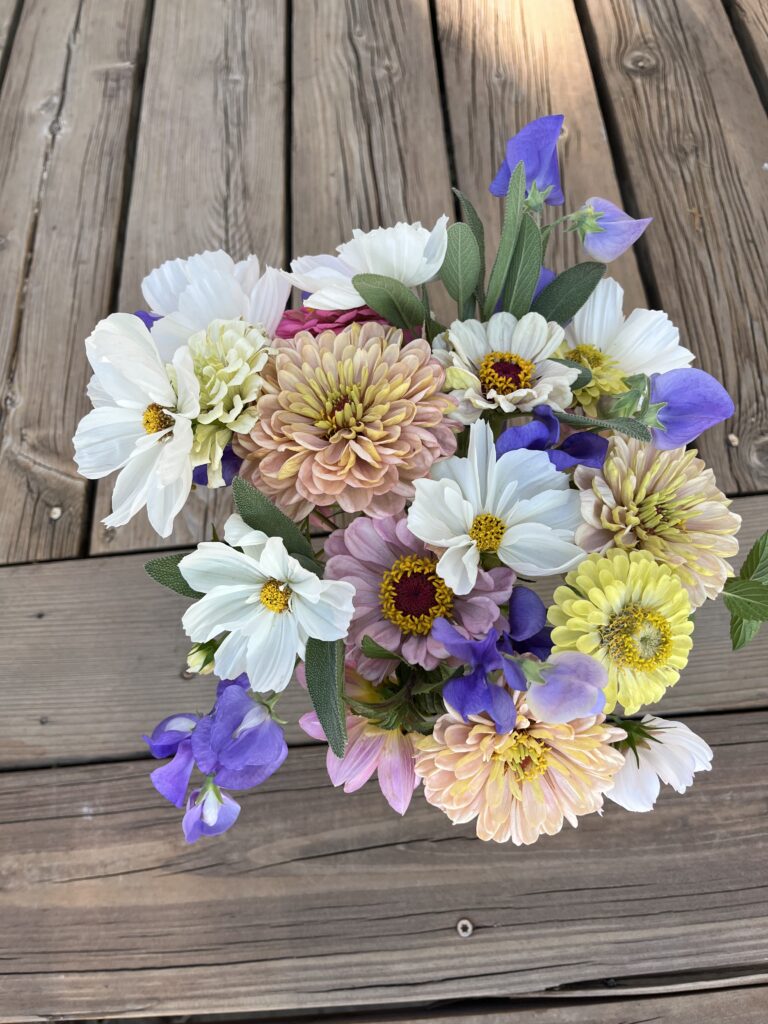
End of Season Care
Zinnias are annuals. At the end of the season, you can collect seeds from the flowers to plant the following year. Simply let the flowers dry on the plant, and when the flower heads are completely dead and dry, collect the seeds and store them in a cool, dry place.
Gorgeous Zinnia Varieties:
- Benary’s Giant Zinnias: These zinnias come in a variety of colors, including red, pink, yellow, orange, and white. The flowers are also large with many petals
- Ballerina Pink: This is a new variety from Johnny’s Selected seeds. They are a soft pink with many petals, and a large flower head. I am going them this year and cannot wait! (Of course I will share the results here!)
- Queeny Formula: These zinnias are two toned lime green and pink/purple colors. They are a show stopper and absolutely gorgeous.
- Zinderella Peach: These zinnias have a distinct shape that reminds me of a lion’s face and mane. They are also a beautiful soft pink.
- Envy: These are a personal favorite of mine. Their many petals and lime green color are a stand out for me.
- There are always new varieties of zinnias. Some of my favorite places to look for zinnia seeds are Floret Flowers, Johnny’s Select Seeds, and Baker Creek.
Common Questions When Growing Zinnias
How do I keep zinnias blooming all summer?
Keep cutting the flowers! Even if you let some flowers bloom on the plant cut them off for the plant to put more energy into growing more flowers and not creating seeds.
How tall do zinnias grow?
How tall the zinnia can grow will depend on the variety. Usually the front of the seed packet will say how tall the plant can get. Some varieties are bread for pots and will not grow as tall as non pot varieties.
Do zinnias come back every year?
No, zinnias are annuals. You will need to replant every spring after any danger of frost.
What temperature will kill zinnias?
Zinnias are frost sensitive. When night temps are below 32 degrees they will die.
Do zinnias need full sun?
Yes, zinnias need 6-8 hours of full sun.
How do you keep growing zinnias short and bushy?
If you want zinnias to be short, first plant pot varieties. When your plant has reached 6-8 inches tall and has 4-5 sets of leaves. Pinch or cut the top stem and leaves off the plant. This will make the plant have two main stems instead of one. This will result in a bushier plant and more flowers with longer stems. You can continue to do this with each stem so the plant will continue to branch.
What month do you plant zinnias seeds?
Plant zinnia seeds after the last frost in spring when your night temperatures are no lower than 40 degrees. Usually anytime April-July, but check your weather and last frost date to be sure.
What happens if you plant zinnias too close together?
If planted to close the plant will not grow as large, have limited blooms, and will be more susceptible to pests and disease.

More Gardening Post You Will Love
Easy Seed Starting for Beautiful Flowers: Tips and Tricks
Simple Cut Flower Garden Layout Plans for Small Spaces
How to Start a Cut Flower Garden for Beginners- Top 5 Flowers
Grow Your Perfect Cutting Flower Garden This Year!
As always,
Grow flower to heal your soul,
Beth
